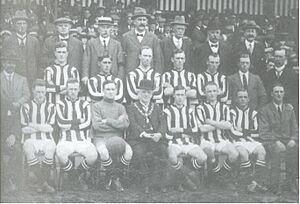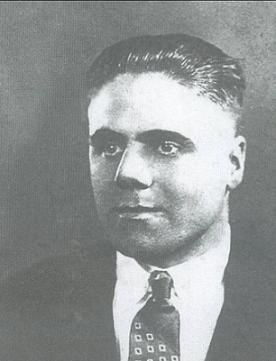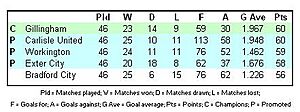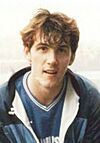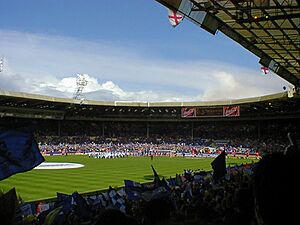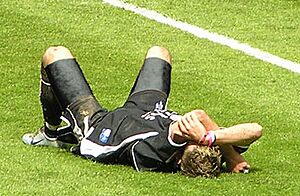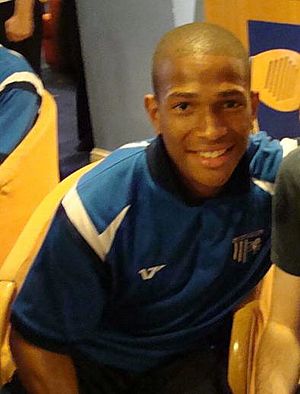History of Gillingham F.C. facts for kids
Gillingham Football Club is a football team from Gillingham, Kent, England. The club started in 1893. They played in the Southern League until 1920. That's when the top teams from the Southern League joined the Football League as its new Division Three.
Gillingham was voted out of the league in 1938 but came back 12 years later. This was when the league grew from 88 to 92 clubs. In the late 1980s, Gillingham almost reached the second-highest level of English football. However, their performance then dropped. In 1993, they just avoided falling into the Football Conference.
In 2000, the "Gills" (as they are called) reached the second tier of the English league for the first time ever. They stayed at this level for five seasons. Their highest league finish was 11th place in 2002–03. The club has won the fourth level of English football twice. They won the Football League Fourth Division in 1963–64 and the Football League Two in 2012–13.
Contents
How Gillingham FC Started: 1893–1920
A local junior team, Chatham Excelsior F.C., was doing well. This inspired a group of business people to meet on May 18, 1893. They wanted to create a football club that could play in bigger competitions. To do this, they needed a fenced-off playing area. This way, they could charge people to watch games. Excelsior didn't have such a place.
The new club, New Brompton F.C., was formed at this meeting. Many Excelsior players joined the new team. The group also bought the land that would later become Priestfield Stadium. A pitch was quickly made, and a building for players was put up.
New Brompton's first team played their first match on September 2, 1893. The new team wore black and white stripes, like Excelsior. They lost 5–1 to Woolwich Arsenal's reserve team. About 2,000 fans watched the game. Before this main match, New Brompton's reserve team played against Grays. This was technically the very first game played by a team from the club.
Joining the Southern League
New Brompton joined the Southern League when it started in 1894. They were placed in Division Two because they were one of the last clubs to be invited. When they joined, New Brompton became a professional club. Players agreed to be paid 12 shillings per match. They quickly won the Division Two championship in the 1894–95 season.
The team had a great record: only one loss and eleven wins from twelve matches. They ended the season with a "test match" against Swindon Town. Swindon had finished last in Division One. New Brompton won 5–1 and were promoted to Division One the next season.
In 1896, the club hired its first manager, William Ironside Groombridge. He had been the club's money manager before. Groombridge worked for the club as a secretary and sometimes manager until after the First World War.
New Brompton found it tough in Division One. They usually finished near the bottom of the table. However, they reached the first round of the FA Cup for the first time in 1899–1900. They lost 1–0 to Southampton. In the same season, the club had to play a league game at Woolwich Arsenal's home ground. This was because Priestfield was closed due to crowd trouble during a match against Millwall.
In the 1907–08 season, New Brompton finished last. This was under the manager Stephen Smith, a former England player. They avoided being moved down only because the league expanded. But they did win a cup game against First Division team Sunderland. This game is remembered for a hat-trick scored by Charlie McGibbon.
Becoming Gillingham F.C.
In 1912, the club's directors decided to change the name to Gillingham F.C.. The team played under this name in the 1912–13 season. However, the change was not officially approved by the shareholders until the next year. With the name change, the team also started wearing a new kit. It had red shirts with blue sleeves.
The team finished last in the division again in the 1914–15 season. But they avoided being moved down a second time. This was because the league was stopped due to the start of the First World War.
When football started again after the war, Gillingham wore black and white stripes again. They continued to struggle. They finished last in Division One in the 1919–20 season. For a third time, the club avoided being moved down. This was because all Southern League Division One clubs were moved up to form the new Football League Third Division.
Joining the Football League: 1920–1938
In their first game in the new Football League Division Three, Gillingham drew 1–1 with Southampton. This was at Priestfield, in front of a new record crowd of 11,500 fans. Tom Gilbey scored the club's first goal in league games.
Under new manager John McMillan, the team struggled. They finished the 1920–21 season last in the table. In the years that followed, there wasn't much improvement. The club often finished near the bottom of the lowest division.
Gillingham didn't finish in the top half of the table until 1925–26. They finished 10th that season. This was mainly due to the goals of Dick Edmed. He was soon signed by Liverpool for £1,750, a new record for Gillingham. Manager Harry Curtis left soon after to manage Brentford.
Former Wolverhampton Wanderers manager Albert Hoskins then took over. But he couldn't change the team's luck. He left in 1929 after Gillingham finished last again.
Striker Fred Cheesmur set a new club record in the 1929–30 season. He scored six goals in one match against Merthyr Town. This is still the most goals scored by a Gillingham player in a professional game. But it was a rare highlight in a season where Gillingham had to ask to be voted back into the league.
The next year, the club stopped using its black and white striped shirts. They started wearing blue shirts and white shorts. These colors have been linked with Gillingham ever since. However, the black and white stripes are still on the club's current badge.
In 1932–33, former Crystal Palace manager Fred Maven led the club to its highest league finish so far. They finished 7th that season. But they couldn't repeat this success. The team went back to struggling at the bottom of the table the next season.
In the 1934–35 season, a sad event happened. Centre-forward Sim Raleigh was the club's top scorer the previous season. He was seen as a future star. On December 1, he suffered a serious injury to his head during a match against Brighton & Hove Albion. He played on but collapsed in the second half. He died in the hospital later that day. The club started a fund that raised over £250 for his wife and child.
In 1938, the Gills finished last in the Third Division South again. They had to apply to be voted back into the Football League for the fifth time since 1920. This time, the club's request to be re-elected failed. Ipswich Town received 36 votes, while Gillingham got 28. Ipswich Town was promoted into the League.
At that time, many thought Gillingham might not survive. They had a lot of debt from the unsuccessful seasons. But the club kept going. They returned to the Southern League the next season. Manager Alan Ure left and was replaced by Bill Harvey.
Outside the Football League: 1938–1950
The club's second time in the Southern League was stopped by the start of the Second World War in 1939. The new manager, Archie Clark, and most players were assigned to work at the local dockyards.
When competitive football started again, Gillingham played in the first Kent League. They won the title in both 1944–45 and 1945–46. In the second of these seasons, the team also won the Kent Senior Cup, Kent County Challenge Cup, and Kent League Cup. They won every major trophy in the county!
After their Kent League wins, the Gills returned to the Southern League for the 1946–47 season. The team won two more trophies: the Southern League Cup and the Southern League title itself. They also had a club record 12–1 victory over Gloucester City. Striker Hughie Russell scored nine goals in that match. He almost got double figures but hit the bar late in the game.
Gillingham didn't win the Southern League title the next season, finishing second. But the team won the Kent Senior Cup again. They also set a club record attendance of 23,002 for a cup match against Queens Park Rangers.
Gillingham applied to be voted back into the Football League in the summer of 1948. Even though they made a nice booklet showing their achievements, their application was rejected. Only one vote was cast in their favor. Despite this disappointment, the team continued to play strongly in the Southern League. They won the league title again in 1948–49.
In 1950, plans were announced to make the Third Division South bigger. It would go from 22 to 24 teams. Because of their success in the local leagues, Gillingham was voted back into the Football League. They received the most votes among the clubs trying to join.
Back in the Football League: 1950–1974
Gillingham's first game back in the Football League was a 0–0 draw at Priestfield. They played against another new team, Colchester United. 19,542 fans watched the game. In the 1950–51 season, the Gills both let in and scored nine goals in different matches. They finished last in the table, and this happened again the next season.
In 1952, striker Jimmy Scarth set a Football League record. He scored a hat-trick in about 2 minutes and 30 seconds against Leyton Orient. This was officially the fastest hat-trick in Football League history until February 2004.
Gillingham's performance slowly got better. The team finished in the top half of the Third Division South three times. This was helped by the goals of Ernie Morgan. In 1954–55, he set a new club record by scoring 31 league goals.
However, in 1956–57 and 1957–58, the Gills were again at the bottom of the table. This meant that when the league system was changed for the 1958–59 season, the team was placed in the new Fourth Division. If they had finished in the top half, they would have been in the new national Third Division. 1958 also saw the departure of long-serving manager Archie Clark. He had been in charge since before the Second World War. Harry Barratt took over.
The Gills were still in the Fourth Division in 1962. Barratt was replaced as manager by Freddie Cox. Cox took over a team that had just finished 20th. Cox worked to build a new team known for its strong defense. After finishing 5th in 1962–63, Gillingham won promotion the next year. They won the first league championship in the club's history. Goalkeeper John Simpson set a new club record by letting in only 30 goals all season. The team finished with 60 points, the same as Carlisle United. But Gillingham won the title because they had a slightly better goal average.
Gillingham started well at the higher level. They almost got promoted twice. But then their performance dropped. The club was moved back down to the Fourth Division in 1970–71. However, the Gills quickly bounced back. They were promoted back to the Third Division in 1973–74. This was under the management of Andy Nelson. With help from players like Brian Yeo, who scored 31 league goals (matching Ernie Morgan's record), Gillingham scored a club record total of 90 league goals. They finished second to Peterborough United.
Ups and Downs: 1974–1995
After leading the club to promotion, Andy Nelson left to manage Charlton Athletic. He was replaced by Len Ashurst. But Ashurst's time as manager lasted only 16 months. Gerry Summers took over. He brought the club closest it had ever been to promotion to Division Two. In 1978–79, Gillingham finished just one point away from a promotion spot.
Two years later, Summers was replaced by Keith Peacock. Peacock built a team known for exciting, attacking play. He also helped many young players from the club's youth ranks become successful at higher levels. These included Micky Adams, Steve Bruce, and Tony Cascarino. Cascarino was famously bought from a non-league team, Crockenhill, in exchange for some tracksuits!
Gillingham almost got promoted several times during Peacock's time. They had four top-six finishes in six years. In 1986–87, they reached the play-offs (in their first year). But they lost in the final to Swindon Town. The two teams were tied 2–2 after the home and away games. So, they had to play a third match at a neutral place, which Swindon won 2–0.
The club's failure to get promoted meant they couldn't keep the talented Cascarino. He was sold to Millwall for £225,000. Even without their star striker, the Gills' 1987–88 season started with many goals. On two Saturdays in a row, Gillingham beat Southend United 8–1 and Chesterfield 10–0. The 10–0 win was a new club record for a professional match.
But the early season promise faded. In December, Peacock was controversially fired after a 6–0 loss to Aldershot. His assistant, Paul Taylor, became manager. But after a difficult time, Taylor was replaced in October 1988 by former Tottenham Hotspur manager Keith Burkinshaw. Burkinshaw couldn't improve the team's results. He left shortly before the club was moved down to Division Four at the end of the 1988–89 season.
Former Gillingham player Damien Richardson became the next manager. Veteran goalkeeper Ron Hillyard was his assistant. But the club's money situation was bad. The pair struggled to get good results with a team of older players and young, untested ones. Both men were fired in September 1992. Glenn Roeder took over as manager.
Gillingham's place in the league was at risk for most of the 1992–93 Division Three season. Being moved down to the Football Conference was very possible. But a 2–0 win over Halifax Town in the last home match of the season saved the club's league status. Still, the money problems continued at Priestfield. Even though the team's league form slowly got better over the next two seasons, it didn't hide the fact that the club was in real danger of closing down.
The club eventually went into receivership in January 1995. By the end of the 1994–95 season, Gillingham faced being kicked out of the Football League and shut down. Fans wondered if they had seen the last Gills match ever. However, help arrived when the club was bought at the last minute.
A New Start: 1995–2000
In June 1995, a salesman from London named Paul Scally stepped in. He bought the club for a very small fee. Scally brought in a new manager, Tony Pulis. Pulis signed almost a whole new team. He led Gillingham to promotion in his first season, finishing second in Division Three (now Football League Two). This season was also special because the team only let in 20 league goals. This was a league record for a 46-game season.
In 1999, Gillingham reached the play-offs again. But they lost in the Second Division play-off final against Manchester City. The Gills were leading 2–0 with less than two minutes left. This was thanks to goals from the strong partnership of Robert Taylor and Carl Asaba. But Manchester City scored twice, with the equalizer coming in injury time. Then, Manchester City won a penalty shoot-out 3–1.
Soon after the play-off loss, Pulis was fired for serious misconduct. Peter Taylor replaced him as manager. In the 1999–00 season, Gillingham had a club-record run in the FA Cup. They beat then-Premiership teams Bradford City and Sheffield Wednesday. They then lost 5–0 to Chelsea in the quarter-finals.
The team also finished third in the league. This meant they qualified for the play-offs again. They faced Wigan Athletic at Wembley Stadium in the final. The game was 1–1 after 90 minutes. But thanks to goals in extra time from Gillingham substitutes Steve Butler and Andy Thomson, the club was promoted to the second tier of the English league (Division One) for the first time. Since Taylor had only signed a one-year deal, Leicester City, then in the Premiership, asked him to be their new manager.
The Division One Years: 2000–2005
Former team captain Andy Hessenthaler was appointed player-manager. He had been a player-coach before. He led the club to league finishes of 13th, 12th, and 11th in his first three seasons.
However, the 2003–04 season was different. The club barely avoided being moved down. A 0–0 draw on the last day kept Gillingham above Walsall on goal difference. Only one goal separated the two teams.
John Gorman was brought in to help Hessenthaler. The team started the 2004–05 season poorly. As the team continued to struggle, Hessenthaler resigned as manager in late November. He still stayed on as a player, which was unusual. Gorman took over as temporary manager but left the club to manage Wycombe Wanderers.
Gillingham then appointed former Burnley boss Stan Ternent as manager. Despite a late run of good results, he couldn't stop the Gills from being moved down to League One on the last day of the season. In a reversal of the previous season, Crewe Alexandra, the team just above Gillingham, survived by only one goal.
Back to Lower Divisions: 2005–Present
The 2005–06 season started with Neale Cooper as the new manager. They had a good 3–2 victory over Premiership team Portsmouth in the League Cup. But the team struggled in the league. Soon after losing in the first round of the FA Cup to a non-league team, Burscough, Cooper resigned.
He was replaced by Ronnie Jepson. Jepson led the team to a mid-table finish, and he did the same in 2006–07. After a bad start to the 2007–08 season, Jepson resigned. Mick Docherty and Iffy Onuora were appointed as joint temporary managers. Docherty left a month later, but Onuora stayed in charge until Mark Stimson was appointed on November 1, 2007. At the end of the season, the club was moved down from League One.
The next season, the Gills earned promotion through the play-offs. They finished fifth in the league. Simeon Jackson scored the only goal in the final against Shrewsbury Town at Wembley Stadium. However, in the 2009–10 season, the Gills were moved back down to League Two. Stimson left the club by agreement two days after the season ended. Within two weeks, Andy Hessenthaler returned for his second time as manager.
For two seasons in a row, the Gills finished just outside the play-off spots in League Two. After this, Hessenthaler moved to the role of Director of Football. Martin Allen was appointed as manager. In the 2012–13 season, the club was promoted back to League One. They won the League Two championship, which was only the second title the club had ever won at a professional level. This was helped by a new club record of eleven away wins in a season.
However, the following October, Allen was fired after a bad start to the season. Peter Taylor was appointed manager for a second time. Taylor was fired after fourteen months in the job. His successor, Justin Edinburgh, lasted until January 2017. Former Gillingham player Adrian Pennock returned as manager. But the team almost got moved down at the end of the 2016–17 season. Pennock left the club by agreement in September 2017. Steve Lovell, another former Gills player, took charge. Lovell left the club two games before the end of the 2018–19 season.
Images for kids


